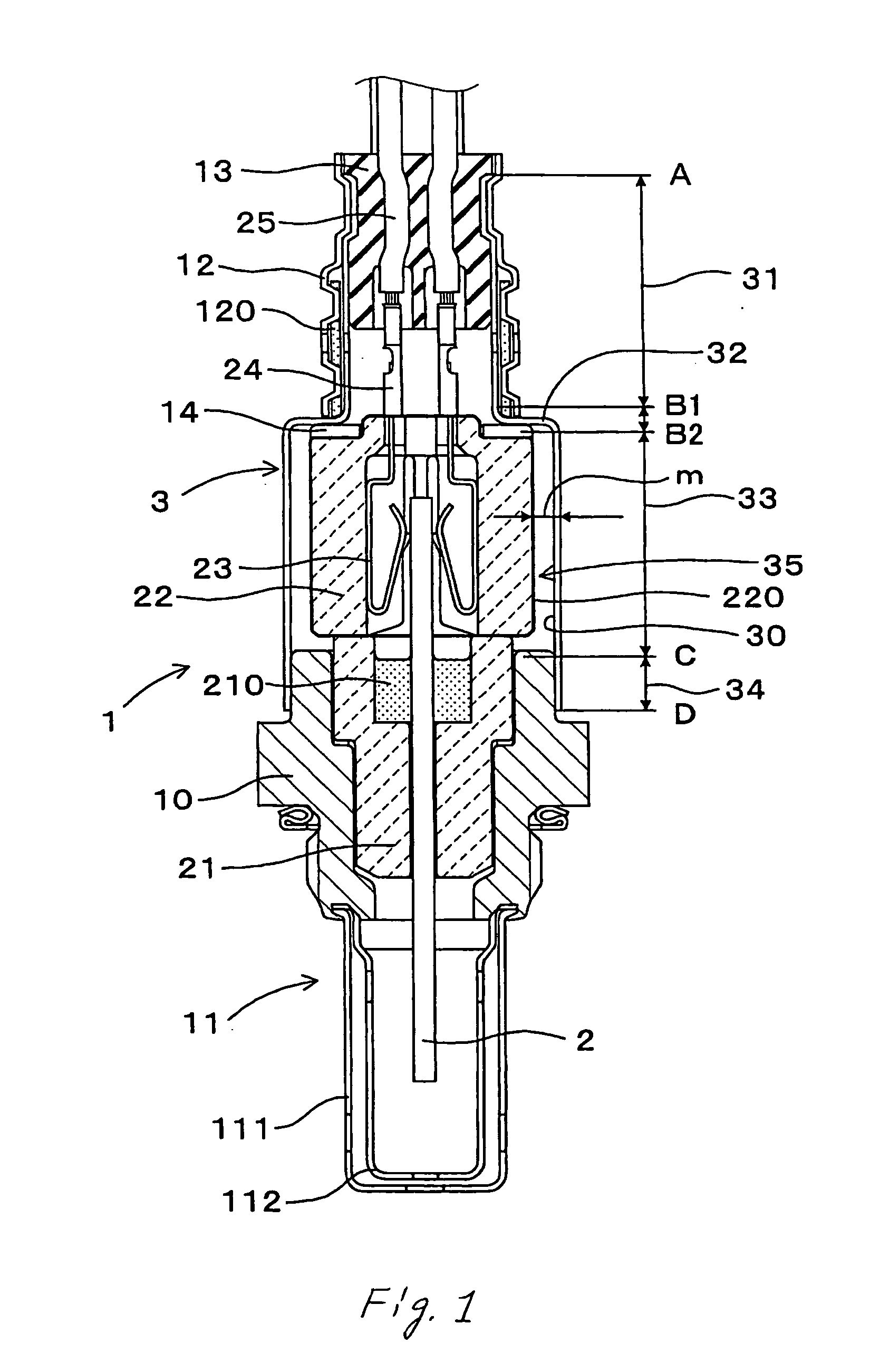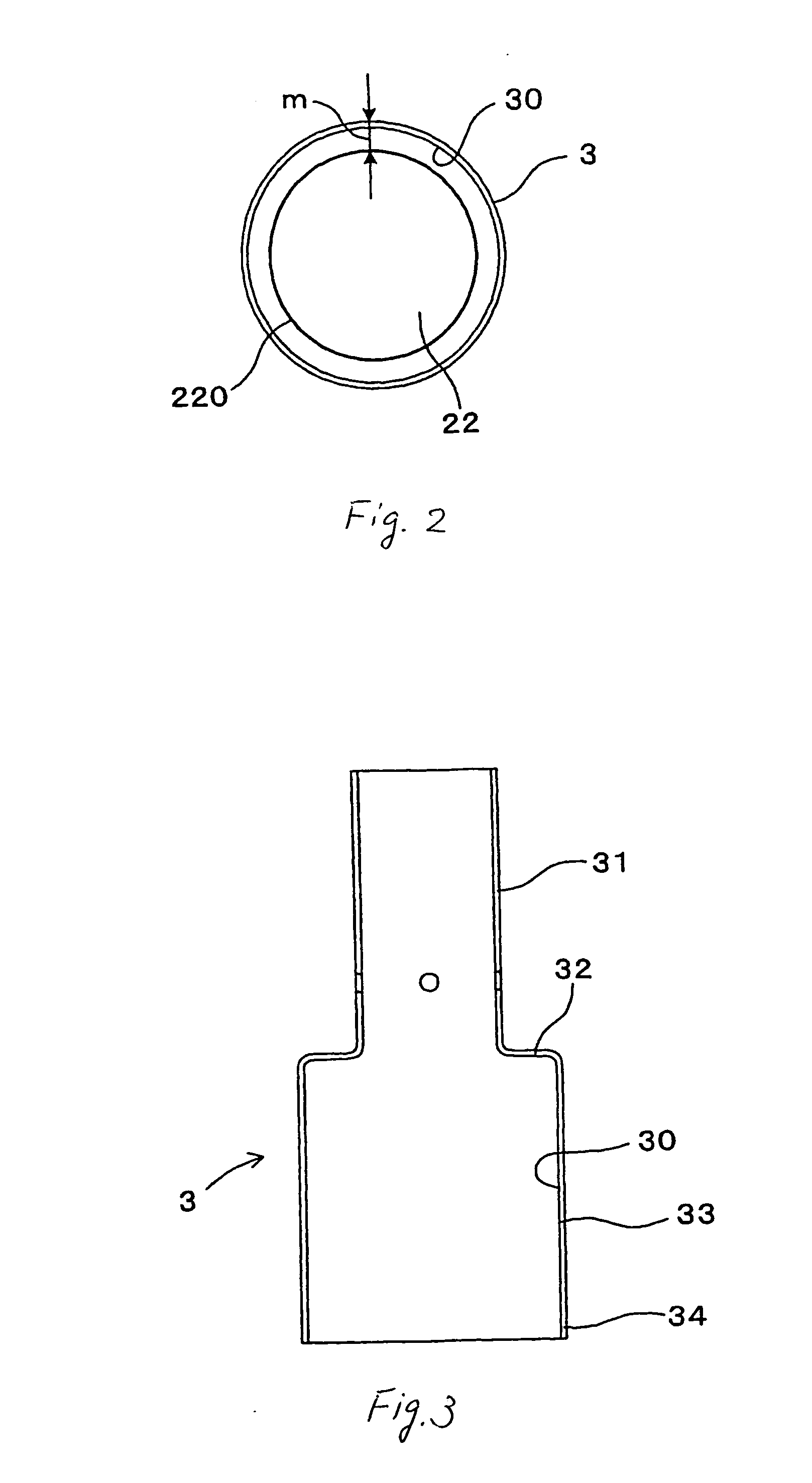Structure of gas sensor designed to reduce mechanical damage to sensor element
- Summary
- Abstract
- Description
- Claims
- Application Information
AI Technical Summary
Benefits of technology
Problems solved by technology
Method used
Image
Examples
first embodiment
[0037] Referring to the drawings, wherein like reference numbers refer to like parts in several views, particularly to FIG. 1, there is shown a gas sensor 1 according to the invention which may be employed in an air-fuel ratio control system for automotive vehicles to measure the concentration of a component such as O2, NOx, CO, or HC contained in exhaust gasses of the engine The gas sensor 1 may also be of a limited current type or a concentration dependent electromotive force type which is well known in the art as measuring the concentration of oxygen.
[0038] The gas sensor 1 generally includes a sensor element 2, a lower porcelain insulator 21, an upper porcelain insulator 22, a hollow cylindrical housing 10, a cylindrical protective cover assembly 11, and a cylindrical air cover 3. The sensor element 2 may be made of a laminated solid electrolyte body or cup-shaped solid electrolyte body and have a heater embedded therein or affixed thereto to heat the sensor element 2 up to an a...
second embodiment
[0050]FIGS. 4, 5, and 6 show the gas sensor 1 according to the invention.
[0051] The gas sensor 1, like the one in FIG. 1, consists of the cylindrical housing 10, the sensor element 2 disposed within the housing 10 through the lower porcelain insulator 21, the protective cover assembly 11 installed in the top end of the housing 10, the cylindrical air cover 3 fitted on the base end of the housing 10, and the upper porcelain insulator 22 encompassing the base end portion of the sensor element 2 within the air cover 3.
[0052] The air cover 3 consists of the small-diameter portion 31, the shoulder 32, the large-diameter portion 33, and the press-fit end 34. The air cover 3 is made up of two parts in terms of hardness: one is a harder portion including the small-diameter portion 31, the shoulder 32, and the large-diameter portion 33 and the other is a softer portion including the press-fit end 34. The harder portion has a Vickers hardness of 200 to 400 (e.g., 250), while the softer porti...
third embodiment
[0061]FIGS. 9, 10, and 11 show the gas sensor 1 according to the invention.
[0062] The gas sensor 1, like the one in FIG. 1, consists of the cylindrical housing 10, the sensor element 2 disposed within the housing 10 through the lower porcelain insulator 21, the protective cover assembly 11 installed in the top end of the housing 10, the cylindrical air cover 3 fitted on the base end of the housing 10, and the upper porcelain insulator 22 encompassing the base end portion of the sensor element 2 within the air cover 3.
[0063] The large-diameter portion 33 has, as clearly shown in FIGS. 10 and 11, a corrugated wall waving in a circumferential direction thereof to enhance the rigidity thereof. Specifically, the large-diameter portion 33 has recesses 36 and protrusions 37. Each of the recesses 36 is located between adjacent two of the protrusions 37 and formed by crimping the wall of the large-diameter portion 33 inwardly. The recesses 36 and the protrusions 37 extend in a longitudinal ...
PUM
 Login to View More
Login to View More Abstract
Description
Claims
Application Information
 Login to View More
Login to View More - R&D
- Intellectual Property
- Life Sciences
- Materials
- Tech Scout
- Unparalleled Data Quality
- Higher Quality Content
- 60% Fewer Hallucinations
Browse by: Latest US Patents, China's latest patents, Technical Efficacy Thesaurus, Application Domain, Technology Topic, Popular Technical Reports.
© 2025 PatSnap. All rights reserved.Legal|Privacy policy|Modern Slavery Act Transparency Statement|Sitemap|About US| Contact US: help@patsnap.com



